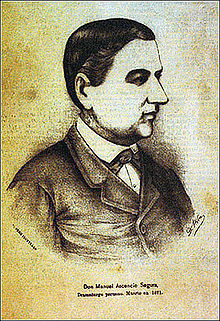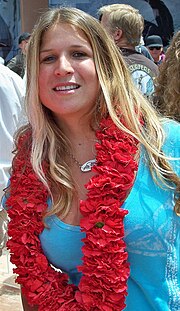Culture of Peru
| This article is part ofa serieson the |
| Culture of Peru |
|---|
 |
|
Peru portal |
Peruvian cultureis the gradual blending of Amerindian cultures with European and Asian ethnic groups. The ethnic diversity and ruggedgeography of Peruallowed diversetraditionsand customs to co-exist. Peruvian culture has been deeply influenced by Native culture,Spanish culture,andAsian culture.[1][2][3]Other minor influences on their culture are Chinese, Japanese, and other European peoples.[4][5]
Literature
[edit]
Peruvian literature has been shaped by the convergence of indigenousoral traditionand the technical resources ofwritingintroduced by the Spanish. This fusion, from the very beginning, enabled the collection and expression of the diverse and complex cultural realities that came into conflict after theconquest.
QuechuaandAymaraliterature, transmitted orally, was deeply linked toreligious,agricultural, romantic, festive, and funerary rituals. These characteristics are reflected in certain forms ofpoetryandprose,as seen in the early historical chronicles, including theComentarios Reales[6]byInca Garcilaso de la VegaandNueva Crónica y Buen Gobierno[7]byFelipe Guaman Poma de Ayala.Also notable is the connection between the yaravíes and patriotic andromantic poetry,represented in the work ofMariano Melgar.[8]
During thecolonialand republican periods, the dominance of thecriollooligarchyin Peruvian society favored the adoption of European literary forms at the expense ofindigenous ones.In this context,neoclassicalauthors such as Manuel Ascensio Segura andFelipe Pardo y Aliagaemerged, dominating the literary scene until the late 19th century whenromanticismtook hold through figures like Carlos Augusto Salaverry and José Arnaldo Márquez.[9]The crisis resulting from theWar of the Pacificpaved the way formodernism,with exponents such asJosé Santos ChocanoandJosé María Eguren.

In the 20th century,avant-garde movementsgained strength, driven by magazines likeColónidaandAmauta,the latter founded in 1926 byJosé Carlos Mariátegui,with notable collaborators such asCésar Vallejo.[10][11]Meanwhile,indigenismresurfaced in the poetry of Luis Fabio Xammar.[12]Theavant-garde movementsfragmented into variouslyricalproposals, such as those ofXavier Abril,Alberto Hidalgo,Sebastián Salazar Bondy,Carlos Germán Belli,among others, opening new and diverse expressive fields.
In 19th-century Peruvian prose, thecostumbrismoof Manuel Ascensio Segura andRicardo Palma,along with themodernismofManuel González PradaandJosé Santos Chocano,set the literary course. By the 20th century,indigenistprosereached some of its peak moments withCiro AlegríaandJosé María Arguedas,whose influences extended to authors such asSebastián Salazar Bondy,Manuel Scorza,andJulio Ramón Ribeyro.Mario Vargas Llosa[13]andAlfredo Bryce Echenique,[14]while maintaining a realist approach, incorporated newnarrative techniques.
Inpoetry,prominent figures include Emilio Adolfo Westphalen,Jorge Eduardo Eielson,Carlos Germán Belli,Arturo Corcuera,Antonio Cisneros,Wáshington Delgado,Marco Martos,and Carmen Ollé. Incontemporary narrative,notable authors includeMiguel Gutiérrez,[15]Gregorio Martínez,Alonso Cueto,andGustavo Rodríguez,among others.
Art
[edit]
Peru's cultural heritage originates from the ancientAndean civilizationsthat emerged in its territory before the arrival of the Spanish.[16]The archaeological treasures ofPerutestify to a significant cultural development that occurred without contact with other extracontinental cultures.
The earliest artistic expressions with a high degree of intellectual and technological evolution are found in the sites ofChavín de HuántarandCupisnique,dated between the 9th and 4th centuries BCE.[17]These expressions include silver and goldjewelry,ceramics,architecture,andstone sculpture,reflectingsymbolicandreligious art.[18]
Between the 8th century BCE and the 1st century CE, theParacas CavernasandParacas Necrópoliscultures developed. The former produced polychrome ceramics with religious representations, while the latter is known for its monochrome ceramics and complex, delicate textiles.

In the period between the 3rd century BCE and the 7th century CE, the urban cultures of theMocheinLambayequeand theNazcain the Río Grande valley inIcaemerged.[19]Both cultures are notable for their advancedterrace agriculture,hydraulic engineering,andceramic,textile,pictorial,andsculpturalproductions.
TheWari civilization,between the 7th and 12th centuries, established inAyacucho,pioneered rational urban design, a concept that spread to other areas such asPachacámac,Cajamarquilla,andWari Willka.TheTiahuanaco culture,which developed on the shores ofLake Titicacabetween the 9th and 13th centuries, is known for its monumental stonearchitectureandsculpture,facilitated by the use ofbronze.
TheChimú people,between the 14th and 15th centuries, built the city ofChan Chanin the Moche River valley inLa Libertad,and they excelled injewelry-making andhydraulic engineering.

TheInca civilization,which absorbed much of the cultural legacy of its predecessors, left significant evidence such as the cities ofCuzco,the architectural remains ofSacsahuamánandMachu Picchu,and a network of roads connectingCuzcowith other regions of theempire.[20]The arrival of the Spanish led to a cultural blending reflected inPeruvian architecture,combining European styles with indigenous influences. After theRenaissance period,theBaroquereached a rich expression in buildings such as theConvent of San FranciscoinLimaand theIglesia de la CompañiainCuzco.
TheWar of Independencecreated a creative void that French-inspiredNeoclassicismattempted to fill. During the 20th century, architectural eclecticism was observed, with constructive functionalism emerging as a response, exemplified by thePlaza San MartíninLima.
Peruvian sculpture and painting developed from workshops founded by religious figures, influenced by the Sevillian Baroque school. This artistic movement can be seen in works such as the choir stalls of thecathedraland the fountain in thePlaza de Armas of Lima.

Artistic mestizaje was more evident in painting, which incorporated elements of native heritage. Examples include the portrait of the imprisoned Atahualpa by Damián de la Bastida y Mora and the works of artists such asMateo Pérez de Alesio,Angelino Medoro,Francisco Bejarano, Jesús de Illescas, and Joaquín Rodríguez.[21]
During the 17th and 18th centuries,Baroquedominated thevisual arts,while in the 19th century,French NeoclassicalandRomanticcurrents found their best representatives inLuis Montero,Ignacio Merino,and Francisco Masías.[22]
In the 20th century, the foundation of theSchool of Fine Arts of Limain 1919 marked a milestone in Peruvian sculpture and painting. Notable sculptors include Luis Agurto, Luis Valdettaro,Joaquín Roca Rey,Jorge Piqueras,Alberto Guzmán,Víctor Delfín,and Francisco Sánchez, and painters such asDaniel Hernández Morillo,Ricardo Grau, César Quispez Asín, andJosé Sabogal.The latter led the indigenist movement, a pillar of contemporary Peruvian painting, with representatives such asFernando de Szyszlo,Alberto Dávila,Armando Villegas,Sabino Springett, Víctor Humareda, Mario Alejandro Cuadros, Ángel Chávez, Milner Cajahuaringa, Arturo Kubotta,Venancio Shinki,Alberto Quintanilla, Germán Chávez,Tilsa Tsuchiya,David Herskowitz,Óscar Allain,and Carlos Revilla.[23]
Among the most widespread crafts inPeruareceramics,both artistic and utilitarian,carving,silverwork,leather em Boss ing,straw weaving,andtextile work,with colorfulalpaca woolfabrics standing out.
Architecture
[edit]
Peruvian architecture is a conjunction of European styles exposed to the influence of indigenous imagery. Two of the most well-known examples of the Early Colonial period are theCathedral of Cuscoand theChurch of Santa Clara of Cuzco.After this period, the mestization reached its richer expression in theBaroque.Some examples of thisBaroque periodare theConvento de San Francisco,theIglesia de la Compañía,and the facade of theUniversity of Cuzcoand, overall, the churches ofSan AgustínandSanta RosaofArequipa.
Although these later examples are rarer; theIndependence Warleft a creative emptiness that was filled by theNeoclassicism.The 20th century was characterized by theeclecticarchitecture, which has been in stark opposition toconstructive functionalism.Its considerable example isSan Martin PlazainLima.
Music
[edit]
The pre-Hispanic Andean cultures of Peru were distinguished by their rich tradition in artistic expressions, especially in music. Most communal agricultural activities were accompanied by music and songs, known inQuechuaastaqui.[24]The ethnic diversity ofancient Peruresulted in the coexistence of various traditions and customs, which have persisted over time and have been fundamental to the development of post-Hispanic Peruvian folklore.
Today, various musical expressions, such asdanceand song, popular festivals (both religious and non-religious),handicrafts,gastronomy,and other regionally varied activities, are significant aspects of Peruvian and Latin American cultural heritage.[25]
Pre-Hispanic Andean musicians primarily usedwind instruments,such as thequena,pinkillo,erke,antaraorsiku(also known aszampoña), and thepututo.They also employedpercussion instrumentslike thetinya(hand drum),pomatinyas(made frompumaskin), andrunatinyas(made fromhuman skin), used in battles, as well as thewankar,a large drum.
With the arrival of the Spanish, European instruments likeharps,guitars,vihuelas,bandurrias,andluteswere introduced. The combination of these instruments with indigenous ones led to the creation of mestizo instruments, such as the Andean harp and thecharango,which is made from the shell of thearmadillo.[26]
Dances
[edit]
Cultural blending was not limited to the interaction betweenindigenousandEuropean cultures;African influence is also evident in the rhythms and percussion instruments. This influence is reflected in musical forms such asfestejoandzamacueca.
Among the native dances, those related toagricultural work,hunting,andwarfareare prominent.[27]Some of thesechoreographiesshow Christian influence. Two of the most representative Andean dances are thekashua,communal in nature, performed in groups in open spaces, and thewayñoorhuayno,a "salon dance" performed in pairs in enclosed spaces. Other Andean-origin dances include theyaravíandtriste,which are songs with typically very sentimental lyrics.
Ritual dancesinclude theachocallo,pinkillada,llamerada(imitating the movement ofllamas), andkullawada(of the spinners). Hunting-related dances includellipi-puliandchoq'elas,colorful highland dances associated withvicuñahunting.
Warfare dances include thechiriguano,ofAymaraorigin;chatripuli,which satirizes Spanish royalist soldiers; andkena-kenas,referring to the Chilean soldiers who occupiedPeruduring theWar of the Pacific(1879). Carnival dances are also significant, a Western festival that in thePeruvian Andescoincides with theharvest season;manyrural communitiescelebrate withancestral ritesand mestizo dances, marking the initiation of youth and, in many cases, the formation of new couples.[28]
The most internationally recognized Peruvian dance is themarinera norteña,which represents the courtship of a man towards a young woman.[29]There are local variations of this dance inLimaand other regions of the country.

Celebrations
[edit]Popular festivals, which result from thetraditionsand legends of each town, bring together music, dance, typical foods, and drinks. In addition to religious festivals, such asChristmas,Corpus Christi,orHoly Week,there are others that express the syncretism between indigenous andChristian beliefs,such as thealasitasfairs (anAymara wordthat some scholars interpret as "buy me" ), which combine a craft and miniature fair with dances, foods, and a mass.[30]Another important festival is the pilgrimage ofQ'oyllor-riti(Cusco), which integrates the ancient worship of theapus(tutelary deities of themountains) with apilgrimageto a Christian sanctuary, in a walk up to a snow-capped peak over 5,000 meters above sea level.
Sports
[edit]
Footballis the most popular sport in Peru.[31][32]Football in Peruis governed by thePeruvian Football Federation(PFF), which organizes themen'sandwomen'snational teams. Football legends from Peru includeAlejandro Villanueva,Teodoro Fernández,Valeriano López,Alberto Terry,Hugo Sotil,César Cueto,Roberto Challe,Héctor ChumpitazandTeófilo Cubillas,Peru's most successful striker in the World Cup finals with ten goals,Nolberto Solano.
Current renowned players include defenderCarlos Zambrano(Rubin Kazan), midfielderJuan Manuel Vargas(Universitario) and strikersClaudio Pizarro(Werder Bremen),Paolo Guerrero(Flamengo) andJefferson Farfán(Lokomotiv Moscow).Alianza Lima,Sporting CristalandUniversitario de Deportesare the biggest teams in Peru.[33][34]In 2003, Cienciano won theCopa Sudamericanaafter defeating Argentinian clubRiver Plate,[35]and then proceeded to beat Latin American powerhouseBoca Juniors(also from Argentina) in theRecopa Sudamericanaplayed inMiami.[36][37]Sporting Cristal was finalist in the Copa Libertadores de América 1997, South America's most important football tournament. Also Universitario de Deportes, but in 1972.
Achievements from thePeru national football teaminclude competing at theFIFA World Cup,in1930,1970(quarterfinalists),1978,and1982,beingTeófilo Cubillas,among the top 10 goal scorers in the history of theWorld Cupand having a record as the only player to score 5 goals in 2 different World Cups. The national team won two Copa América's in1939and1975.
Claudio Pizarroholds the record as the top scorer from a foreign country in the history ofBundesliga.Paolo Guerreroholds the record as the current all-time top scorer in the history of theCopa Américastill active, finishing as the top scorer in all three of these tournaments (2011,2015and2019), which is also a record.

Achievements from thePeru women's national football teaminclude finishing third place at the1998 Sudamericano Femenino,and finishing fourth place at the2003 Sudamericano Femenino.
Women'svolleyballis a popular and also successful sport in Peru (silver medal in the1988 Summer Olympics,runners-up in the Volleyball World Championship, and 12 times South American champion).[38][39]
Tennis,surfingandrugbyinPeruare minor but growing sports.
Alejandro "Alex" Olmedo Rodríguez(March 24, 1936 – December 9, 2020) was a tennis player from Peru with American citizenship. He was listed by the USTA as a "foreign" player for 1958, but as a U.S. player for 1959.[3] He helped win the Davis Cup for the United States in 1958 and was the No. 2 ranked amateur in 1959. Olmedo won two Majors in 1959 (Australia and Wimbledon) and the U.S. Pro Championships in 1960, and was inducted into the Tennis Hall of Fame in 1987.
Sofía Mulánovichis the first South American ever to win theSurfing World Title,which she did in 2004. She is also the first Peruvian surfer ever to win aWorld Surf LeagueWorld Championship Tourevent. In 2004, she won three out of the six World Championship Tour events, and finished the season as World Champion. Felipe Pomar was also a world champion.
Cuisine
[edit]
Due to the rich variety and the harmony of its flavor and the food used,[40]Peruvian foodis constantly winning internationally and the chefs often have international recognition and distinction.[41][42]One notable element is the constant new innovations and new dishes, especially those that incorporate the food found by experimentation. Each region maintains its rich cuisine by its food having a mix of colors and ingredients.[43]
The great variety of native foods, such ascorn,tomatoes,potatoes,uchuorchili pepper,oca,olluco,avocado,and fruits likecherimoya,lúcuma,andpineapple(ananás), along with animals such astarucas(deer),llamas,andguinea pigs,led to the creation of new dishes and methods of preparation when combined with European and Moorish culinary traditions. The successive arrivals of Africans and Chinese also influenced the development ofcriollocuisine,which is now varied and rich.
Among the most representative dishes ofPeruvian cuisineareceviche(fish and seafood marinated inlime juice),chupe(soup) ofshrimp,anticuchos(grilled beef heart skewers),olluco con charqui,the Andeanpachamanca(meats,tubers,andbeanscooked in astone oven),lomo saltado(stir-fried beef withtomatoesandonions,served withfried potatoesandrice) of Chinese influence, andpicante de cuy.These dishes are often accompanied by typical drinks such aschicha de jora(corn fermented and sun-dried), with very low alcohol content, as well as non-alcoholicchichamade frompurple cornorpeanuts.[44]
See also
[edit]References
[edit]- ^"Indigenous Culture | Multiple Ethnic & Linguistic groups | Northern Peru's Amazon & Andean Regions".Northern Peru & Amazonia Tours | Kuelap & Gocta | Amazon River Cruises & Lodges.Retrieved2022-01-15.
- ^Belknap, Daniel F.; Sandweiss, Daniel H. (2014-06-03)."Effect of the Spanish Conquest on coastal change in Northwestern Peru".Proceedings of the National Academy of Sciences.111(22): 7986–7989.Bibcode:2014PNAS..111.7986B.doi:10.1073/pnas.1404568111.ISSN0027-8424.PMC4050538.PMID24843118.
- ^"Cultural Tidbit: Afro-Peruvian Culture | Ecela Spanish".ecelaspanish.Retrieved2022-01-15.
- ^Walhout, Hannah (April 17, 2019)."How Japanese Immigrants Shaped Peruvian Food".Food & Wine.Retrieved2022-01-15.
- ^"European Contact Overwhelms the Inca Empire: Francisco Pizarro's Conquest of Peru".encyclopedia.Retrieved2022-01-15.
- ^Garcilaso de la Vega, I. (1609). Comentarios reales de los Incas.
- ^Guaman Poma de Ayala, F. (2000). Nueva Crónica y Buen Gobierno.
- ^Puduñay, A. (1989). Literatura quechua: Antología.
- ^Basadre, J. H. (1968). Historia de la República del Perú.
- ^Wiesse, P. (1971). Historia del arte peruano.
- ^Mariátegui, J. C. (1928). 7 ensayos de interpretación de la realidad peruana.
- ^Salazar Bondy, S. (1963). Literatura peruana: 1928-1960.
- ^Vargas Llosa, M. (1969). Conversación en la Catedral.
- ^Bryce Echenique, A. (1965). Huerto cerrado.
- ^Gutiérrez, M. (1989). La ciudad de los perros.
- ^Lumbreras, L. E. (1974). Nuestro Perú.
- ^Burger, R. L. (1992). Chavín and the origins of Andean civilization. University of Texas Press.
- ^Menzel, D. (1964). The art of ancient Peru. Thames and Hudson.
- ^Donnan, C. B. (1978). Moche art and iconography. University of Texas Press.
- ^Isbell, W. H. (1997). The empire of the Inca. University of Chicago Press.
- ^Romero, E. (1970). Historia del Perú.
- ^Wiesse, P. (1971). Historia del arte peruano.
- ^Tauro del Pino, A. (1981). Enciclopedia ilustrada del Perú.
- ^Ramos, C. (1999). Folklore del Perú: Música y Danzas. Editorial Universitaria.
- ^Flores Ochoa, J. (1976). Los Dioses de los Andes: Simbolismo y Arte en las Alturas del Perú. Editorial América.
- ^Romero, R. (1994). Música, Danza y Fiesta en los Andes Peruanos. Fondo de Cultura Económica.
- ^Mujica, E. (2001). El Arte de la Cultura Andina: Música, Danza y Ritualidad. Fondo Editorial de la Pontificia Universidad Católica del Perú.
- ^Valcárcel, L. (1954). El Proceso de la Cultura en el Antiguo Perú. Editorial Huascarán.
- ^Carrión, B. (1989). La Danza en el Perú: Origen y Evolución. Editorial Milla Batres.
- ^Morote, A. (1988). Sincretismo Religioso en el Perú Andino. Editorial Horizonte.
- ^Noticias, A. P."Top 10: Los deportes más populares en Perú - AP Noticias".AP Noticias Perú(in Spanish).Retrieved2022-07-18.
- ^"¿Qué convirtió al fútbol en el deporte más popular? Esta publicación del Fondo Editorial PUCP lo explica".PuntoEdu PUCP.2021-09-17.Retrieved2022-07-18.
- ^PERÚ, NOTICIAS EL COMERCIO (2020-01-24)."Así llegan los tres clubes grandes del fútbol peruano para el comienzo de la temporada 2020| Alianza Lima| Universitario | Cristal | Liga 1 2020 | DEPORTE-TOTAL".El Comercio Perú(in Spanish).Retrieved2022-07-18.
- ^DePeru."Los tres Grandes del Fútbol Peruano".DePeru(in Spanish).Retrieved2022-07-18.
- ^GrupoRPP (2020-12-19)."Tocó la gloria: hace 17 años Cienciano ganó la Copa Sudamericana".RPP(in Spanish).Retrieved2022-07-18.
- ^"Cienciano campeón de la Recopa 2004 - CONMEBOL".conmebol(in European Spanish). 2015-09-07.Retrieved2022-07-20.
- ^de 2022, Por Joaquín Santiago Parra Jordán9 de Junio."Cuando Cienciano logró la descomunal hazaña de salir campeón de la Copa Sudamericana 2003 y la Recopa 2004".infobae(in European Spanish).Retrieved2022-07-20.
{{cite web}}:CS1 maint: numeric names: authors list (link) - ^Comercio, El."Selección de vóley de Seúl 88 | El Comercio Peru".El Comercio.pe(in Spanish).Retrieved2022-07-18.
- ^PERÚ, NOTICIAS EL COMERCIO (2021-07-23)."China campeón y Perú segundo en el mundial de vóley l Bicentenario | BICENTENARIO".El Comercio Perú(in Spanish).Retrieved2022-07-18.
- ^Conrecu (2020-06-18)."Tipos de Cocina Peruana".Con Recutecu.tv(in Spanish).Retrieved2022-07-18.
- ^"Perú mejor destino culinario en el mundo 2021".Excelencias Gourmet(in Spanish).Retrieved2022-07-18.
- ^PERÚ, Empresa Peruana de Servicios Editoriales S. A. EDITORA."¡Excelente! Perú es distinguido como el mejor destino culinario líder en el mundo 2021".andina.pe(in Spanish).Retrieved2022-07-18.
- ^"Por estas 7 razones la cocina peruana es reconocida en el mundo".institutpaulbocuse.usil.edu.pe(in Spanish).Retrieved2021-06-03.
- ^Izaguirre, L. (2012). Gastronomía Peruana: Historia, Cultura y Tradición. Instituto Nacional de Cultura.
Further reading
[edit]- Phipps, Elena; et al. (2004).The colonial Andes: tapestries and silverwork, 1530-1830.New York: The Metropolitan Museum of Art.ISBN1588391310.

